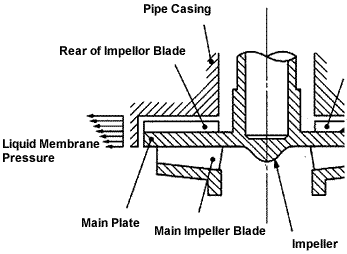Technical Glossary
Corrosive Resistant Pump
Cavitation
Cavitation is the forming and subsequent collapse of bubbles in a liquid when water at normal temperature is pumped up more than 10m and the saturated vapor pressure falls below the static pressure. It’s a phenomenon that occurs when the static pressure drops below the saturated vapor pressure, evaporates or condenses the liquid, thus creates bubbles. When these bubbles collapse, it creates a shockwave, noise and vibration and reduces the efficiency of the machinery, such as screws or pumps. The erosion of the machinery could cause the machinery to be destroyed during cavitation.
When the available NPSH is greater than the necessary NPSH, depending on the given conditions of pipe or pump installation, cavitation will not occur.
Available NPSH
There is a need for a higher static head pressure when the total pressure at the impellor suction is equivalent or higher than the saturated vapor pressure, cavitation in the pump will not occur. This available NPSH (Net Positive Suction Head) can be calculated as follows.
NPSHav=Ha-Hvp±Hs-hl
- Ha:working atmospheric pressure at suction surface (m)
- Hvp:Saturated vapor pressure at that water temperature (m)
- Hs:Suction Total Head (m) (when pumping in +, when pumping up – )
- hl:Suction loss from all piping
Dynamic Seal
In the case of a vertical Molded pump: when the pump is in operation, the centrifugal force at the back of the impellor blade pushes the liquid to the casing, forming a liquid membrane. This effect at the rear of the blade prevents leakage.

Corrosion Resistant Fan/Blower
Gas Volume
The amount of air or gas intake in a particular time unit
m3/min、CMM:gas volume per1 minute
m3/h、CMH:gas volume per1 hour
m3/min、CFM:gas volume per min = cubic feet (used often in America)
1f3/min=0.0283m3/min
Nm3/min:gas volume under normal conditions (0℃, humidity 0%, intake absolute pressure 760mmHg)
Convert into the gas temperature. Calculation is below
![]()
Qt:converted gas temperature t℃ gas volume
QN:requested gas volume under normal conditions
Static Pressure
mmAq:A unit shown in height when the water pumped in or up
Aq=Aqua (water) abbreviation. Waterspout in millimeters (written as mmH2O)
inH2O:If not in millimeters, written in inches. (used often in America)
1 inch=25.4mm
Pa:Pascal (International unit for measuring pressure)
1mmAq=9.80665Pa
kgf/m2:1kgf/m2=1mmAq
bar:bar (European unit for measuring pressure)
1bar=10.197mAq、1mbar=10.197mmAq
Shaft Power
The measure of power used at the shaft of the fan. Shaft power is measured in kW.
Revolution Speed
rpm、(R/M)、min-1:revolution per 1 minute
Gas Specific Weight
kg/m3:Weight per unit volume of gas
Generally1.2kg/m3 is most common under normal conditions (20℃, relative humidity 65%, and absolute pressures 760mmHg)
The specific weight of the gas changes due to temperature variations.
The change in the specific weight of the gas due to temperature is calculated as follows.
![]()
![]() : Specific weight of gas at temperature t℃ of gas kg/m3
: Specific weight of gas at temperature t℃ of gas kg/m3![]() : Specific weight of gas in 0℃ temperature of gas kg/m3
: Specific weight of gas in 0℃ temperature of gas kg/m3
Conversion affected in specific weight volume performance
All the performance labels in the fan catalog (capacity chart) are displayed by the normal atmospheric conditions. Therefore, specific weight becomes 1.2kgf/m3.
Usually under general atmospheric condition there is no problem but when specific weight of the gas differs by a large amount it is necessary to refer to the capacity range chart.
This conversion is calculated as follows
(1) Static Pressure
![]()
SSp=The actual static pressure found in a particular situation (static pressure required by the customer) mmAq
Sp’:Static pressure as shown seen in capacity range chart mmAq![]() : The specific weight of the gas used
: The specific weight of the gas used
(2) Shaft Power
![]()
LB : Actual shaft power kW
LB’ : Shaft power as shown in the capacity range chart![]() : Specific weight of gas being used kg/m3
: Specific weight of gas being used kg/m3
Conversion affected in rotation speed performance
The relation between the change in the blower rotational speed and the change in the gas volume, the static pressure, and the shaft power is proportional as follows.
(1) Gas Volume
![]()
(2) Static Pressure
![]()
(3) Shaft Power
![]()
N1:Rotation speed before change rpm
N2:Rotation speed after change rpm
Q1:Gas volume before change in rotational speed m3/min
Q2:Gas volume after change in rotational speed m3/min
Sp1:Static pressure before change in rotational speed mmAq
Sp2:Static pressure after change in rotational speed mmAq
LB1:Shaft power before change in rotational speed kW
LB2:Shaft power after change in rotational speed kW
Environmental Equipment
Hold Up
Hold up is the volume of liquid retained in the filling during operation.
HOG
An indicator showing the performance of the filling. The lower the indicator, the better the performance. It is varied according to the type and concentration of gas and, the type of filling and capacity of the cleaning fluid.
Flooding
When there is too much cleaning fluid being spayed it fills the airspace in the filling, causing the gas flow to be obstructed. The gas then tries to force its way through, causing the fluid to burst into droplets passed outside with the gas. This phenomenon is called flooding.
Biological Deodorizing Tower
Porous ceramic is used in this deodorizing processing equipment where the carrier filled with living bacterias metabolize and decompose odors through oxidization.
Activated Carbon Absorption Tower
This equipment removes odors with activated carbon.
Cleaning Tower (Scrubber)
When polluted gas enters the equipment, water or harmful elements are neutralized by a chemical solution within the tower. They are then absorbed into a cleaning fluid and further neutralized so that a clean gas may be discharged. This type or cleaning tower is known as a scrubber.



